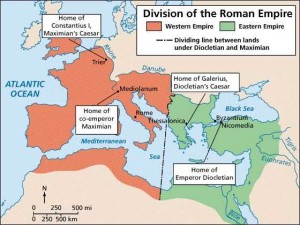Military Expansion:
In 284 C.E. the Senior Augustus, Diocletian expanded the Roman legions fourfold. The empire was at its apex of expansion. The Byzantine author, Lydus, records Diocletian’s army at 389,704 soldiers and 45,562 in the navy fleet.
The army had always taken the largest portion of the empire’s budget. Now, by increasing the military to four times its size, a massive influx of capital would be required. The Roman Empire initiated a new policy of containment of its borders rather than embark on further territorial conquests. With no new sources of booty revenue, the military expenses rose sharply, putting pressure on Diocletian to raise taxes.
Debasement of Currency:
Diocletian inherited an inflationary economy from his predecessors who had devalued their currencies. By the mid-third century silver content of denarius coins was minimal, consisting of copper with a surface silver wash. Neither the government nor individuals placed any value in these coins and refused payments, thus rendering them worthless.
Hoarding of Real Silver and Gold:
As the government debased the coinage people began to stockpile true full grade silver and gold. These informed citizens knew by holding onto the true coinage they would be secure during times of hyperinflation.
Diocletian reformed the mints in 284 but achieved unexpected disastrous consequences. He made law a retariff of the new argenteus silver at 100 denarii and the nummus at 25 denarii. Now, with a currency at an artificial higher tariff rate, inflation began to rise.
Price Controls:
In desperation, Diocletian issued “The Edict of Maximal Prices” in 301. This new law fixed a maximum price that a seller could charge for a specific service or product. Those who were caught selling for higher prices than the government limit were put to death.
The “Edict of Maximal Prices” was repealed after it drove the selling of goods and services to the black market, encouraged a further run up in inflation, and shut down the economy.
The Roman Historian Lactantius writes:
“Because his various iniquities were causing huge inflation, he tried to decree a law about the price of market goods; then, much blood was spilled for small and cheap items, and amid the fear, nothing was put up for sale at all, and inflation flared up even worse until after many deaths, the law had to be repealed.” (Lactantius, On the Deaths of the Persecutors c. 315)
Massive Increase in Taxes:
Lactantius sums up the abuses of Diocletian’s new policies:
“Those receiving money began to outnumber those contributing to such an extent that when farmer’s resources had been eaten up by the size of cash levies, farmland was abandoned and cultivated fields degenerated into woodland . . . the provinces too were cut up into fragments, many governors and more officials encumbered individual regions and almost every city, and likewise, there were many accountants, directors and deputy prefects; . . . and they exacted countless tax payments, I won’t say frequently but always, and during these exactions the injustices were intolerable.” (Lactantius, On the Deaths of the Persecutors c. 315)
Extravagant Building Projects:
As the tax burden multiplied for the citizens, Diocletian’s personal building projects went ahead unabated. In Nicomedia alone, he ordered construction on new buildings throughout the city, a large amphitheater, circus, and imperial palace. Throughout the empire he continued his personal projects. He continued to levy taxes on an unprecedented scale for these programs while hiding away the treasures he already had.
Emperor Worship:
Diocletian raised the status of Emperor to a level higher than anyone prior. The esteemed historian, Roger Rees, comments:
“Eutropius, Ammianus Marcellinus, and also Jerome attribute to Diocletian the beginnings of an elaborately stylized monarchy, characterized by expensive purple dyes, fine silks and jewels, and the obligation on those approaching the emperor to worship him as a god. . . . The later Byzantine scholar chronicler Theophanes even claims that Diocletian’s change in appearance and bearing can be dated precisely to just after the victory over Narses.” (Rees, 46)
Diocletian played his role in the ceremonial display of imperial theatre called adventus (‘arrival’) as they entered cities. The Byzantine scholar Peter Leithart describes such an event:
“The emperor was expected to remain stock still, face fixed in the serene, unsurprised gaze of the gods. He had become a colossus. . . . He appeared borne on a litter or in a carriage; guards in gilt or silver armor flanked him, bearing silk banners designed to float inflated in the air, in the shape of dragons. . . . Eitiquette demanded that he make no response to the throng. He sat still and tried to look enormous.” (Leithart, 48-49)
An account from an ancient roman source, records:
“. . . for he (Diocletian) was the first of all emperors after Caligula and Domitian to allow himself to be called ‘master’ in public, to be worshipped and addressed as a god.” (Rees 93, quoting Sextus Aurelius Victor: Book of the Caesars c. 361)
Another testimony proclaims:
“. . . and he demanded that he be worshipped, where all previous emperors had been greeted. He ornamented his clothes and shoes with jewelry, where before the badge of imperial office was only the purple robe and everything else ordinary.” (Rees, 100, quoting Eutropius’ Brevarium c. 369)
Sometime before 289, the Dyarchs raised the cult status of rulers by taking on a signum, Diocletian called himself ‘Jovius’ (Jupiter) and Maximian ‘Herculius’ (Hercules). In addition, only the inner circle of the emperor’s court could enter behind the imperial veil to gaze upon his holiness or dominus. The empire had now became a ruled by a Dominus, a god incarnate.”
Further evidence by historian D.G. Kousoulas documents:
“He had introduced a rigid protocol in the palace—the few who were admitted to the emperor’s presence were required to bow and kiss the hem of his robe, the gesture he called by the Greek word proskynesis . . .” (Kousoulas, 46)
Diocletian literally believed he was the god Jupiter incarnated in human flesh.
299 – Persecution of Christians in Army.
“There is no date given for Lactantius’ dramatic account of the unsatisfactory outcome of the haruspices’ rites which led to Diocletian’s order that all active soldiers perform sacrifice. The suggestion of 299 or 300 makes for an interesting evolution in Diocletian’s policy. This date falls after some martyr acts for Diocletian’s reign: for instance, for his Christian faith, Maximilian preferred death to recruitment in the army in 295; Marcellus renounced his military service in favor of Christ, and was executed in 298. These men were not victims of persecution edicts but of military regulations, but their examples of insurrection might have triggered Diocletian’s anxiety about the presence of Christians in the army. Eusebius states that the persecution began in the army.” (Rees, 60)
“This persecution began with the brethren in the army. . . ” (Rees, 120 quoting Eusebius, History of the Church c. 324)
“Once when he (Diocletian) was involved in the east, he was sacrificing cattle and searching in their innards for portents. At that moment, some of his attendants present at the sacrifice who had knowledge of the lord put the immortal sign on their foreheads; the demons were put to flight by this action, and the rites were disturbed. The haruspices were anxious and they did not see the usual signs in the entrails, and so, as if they had not made offerings, they sacrificed more times. Again and again the sacrificial victims yielded no sign, until Tagis the chief haruspex said, either out of suspicion or insight, that the rites were not responding because profane men were present at the religious ceremony. Wild with anger at this, Diocletian ordered that not only those attending the rites make sacrifice, but even everyone in the palace, and that if they refused they be flogged as punishment; and he instructed that letters be sent to commanders and soldiers be forced to make the unspeakable sacrifices and that those who disobeyed be discharged from service.” (Rees, 107)
“Diocletian was no coward, but the incident in 299 was alarming. Visiting Antioch, he had participated in a sacrifice that failed. Priests slaughtered the animal, and the haruspex, a soothsayer who foretold the future by reading entrails, stepped forward to take the liver from the hands of the servant. Planting the left foot on the ground, he raised his right foot on a stone and bent low to examine the liver. He found none of the usual indicators. They slaughtered another animal, and another. Nothing. Plutarch had written centuries before about the silencing of the oracles, and the same was happening to Diocletian. His recovery of the Pax Romana was, Diocletian believed, the product of a pax deorum, the peace of the gods. Roman sacrifice was at the center of that peace. It was the chief religious act, the act by which Romans communicated and communed with the gods, keeping the gods happy so Romans could be happy? If the gods stopped talking with the emperor, what would happen to Rome? Did the failed sacrifice in Antioch foretell the end of sacrifice? Did it foretell the end of Rome? What had gone wrong? The presiding diviner investigated and concluded that ‘profane persons’ had interrupted the rites, and attention focused on Christians in Diocletian’s court who had made the sign of the cross to ward off demons during the proceedings. Diocletian was outraged and demanded that all members of his court offer sacrifice, a test designed to weed out Christians. Soldiers were required to sacrifice or leave the sacred Roman army. At least the heart of the empire, in the court and in the army, sacrifices would continue without being polluted by Chrisitians. . . . With the purge of Christians, the problem seemed solved. . .” (Leithart, 16-17)
Christian’s slaughtered as Sacrifices for the Empire’s Woes:
Rulers often look for specific people groups to blame in periods of financial chaos. This torture and slaughter of Christian citizens dwarfed any prior roman persecutions and has been considered the most severe of all.
Diocletian was very superstitious and followed omens and haruspices with pious devotion and obedience. One instance took place in 299 while visiting Antioch:
“Once when he (Diocletian) was involved in the east, he was sacrificing cattle and searching in their innards for portents. At that moment, some of his attendants present at the sacrifice who had knowledge of the lord put the immortal sign on their foreheads; the demons were put to flight by this action, and the rites were disturbed. The haruspices were anxious and they did not see the usual signs in the entrails, and so, as if they had not made offerings, they sacrificed more times. Again and again the sacrificial victims yielded no sign, until Tagis the chief haruspex said, either out of suspicion or insight, that the rites were not responding because profane men were present at the religious ceremony. Wild with anger at this, Diocletian ordered that not only those attending the rites make sacrifice, but even everyone in the palace, and that if they refused they be flogged as punishment; and he instructed that letters be sent to commanders and soldiers be forced to make the unspeakable sacrifices and that those who disobeyed be discharged from service.” (Rees, 107)
Diocletian’s Caesar in the East, Galerius, often incited the Christians as the root of the empire’s ills. Kousoulas writes:
“Galerius had effectively planted the first seed. Lactanius blamed Galerius’ mother Romula, a pagan priestess in her native Moesia (today’s Bulgaria), ‘an extremely superstitious woman who worshipped the mountain deities,’ and who was enraged ‘by the contempt the Christians showed to her sacrifices…She incited her son, more superstitious than even herself, to turn against those people.’ Whatever the personal motives or his mother’s influence, Galerius was the man who suggested to Diocletian that the Christians should no longer be allowed to offend the gods by refusing sacrifice. A few extreme and rather unusual cases of defiance in the army fueled Galerius’ arguments and gave them a sense of urgency.” (Kousoulas, 94-95)
In 302 another incident records:
“…Diocletian, still searching for answers, ‘sent a haruspex to the oracle of Apollo at Didyme,’ near the ancient town of Miletus. Constantine himself, was at the court when the reply came and years later he told the story to Eusebius. ‘[The haruspex reported] that Apollo spoke from a deep and gloomy cavern through a medium, and the voice was not human. [The god] declared that the Pious on Earth were preventing him from speaking the truth and that therefore the oracles that issued from his tripod were without value. This is why he hung down his hair in grief, mourning all the evils that will come to men from the loss of his prophetic spirit. Constantine told Eusebius; ‘I heard the senior Augustus asking his advisors: Who were the pious on Earth? And one of the pagan priests replied: ‘The Christians, of course.’ The Christians indeed were the pious or in Greek evseveis in referring to themselves.” (Kousoulas, 97)
On February 303, the ‘Great Persecution’ was initiated. Leithart comments.
“He began on 23, 303. Dates meant everything to Diocletian. February 23 was the festival of Terminalia (Limits). Established by Numa in the distant Roman past, Terminalia was a festival of boundaries. Neighbors would gather at border stones consecrated to Jupiter, offer sacrifice, and share a meal to maintain friendly relations across property boundaries. . . . Terminalia was also part of the public cult, an annual reconsecration of the boundaries that separated the sacred Roman from the profane non-Roman world. As Jupiter’s incarnation on earth, Diocletian was especially charged with guarding the frontiers, maintaining the sacredness of Rome and its empire, and expelling any pollution that might infect it and bring down the wrath of the gods. As the high priest of the empire, he had purged the Manichaean contagion. Now he needed to deal with the Christians, who posed an even more serious threat. The sect of Christianity had grown out of Judaism, but Diocletian was perfectly tolerant of Jewish citizens. They had their own traditions and had the emperor’s permission to check out of the imperial cult. But at least they had the sense to keep to themselves. These Christians were everywhere. They mixed with other Romans in the markets and even at the court and in the army. . . . Rome would be saved by a baptism in blood, a sacrifice of Christian’s blood.” (Leithart, 20-21)
“The first edict of persecution was drawn up on 23 February 303. It was published (in paper form) the following day in Nicomedia, and elsewhere in the weeks and months that followed. . . . that it ordered the razing of churches, the burning of Christian scripture, the loss of judicial rights for defiant Christians, the loss of relevant rights for Christians in high office, and the enslavement of any defiant Christians serving in the imperial household. It seems that pagan sacrifice was used to establish an individual’s faith in the relevant rulings.” (Rees, 62)
“Terminalia festival of 23 February was chosen . . . When it was twilight that day, the prefect came to the church with generals, tribunes and accountants, and beat the doors down; they looked for the image of God, burnt the scriptures they found, granted booty to everyone, caused plunder, fear, panic. . . . In a few hours the highest building was leveled to the ground. The next day an edict was posted warning that people of that religion would be stripped of all rank and status, that they would be subjected to torture, no matter their class or position.” (Rees, 108, quoting Lactantius On the Deaths of the Persecutors c. 315)
Galerius instigates a ‘false flag’ event to escalate the slaughter of Christians:
“But Galerius was not content with the rulings of the edict; he prepared to beleaguer Diocletian by other means. To force him to a policy of the cruelest persecution, he had attendants secretly start a fire in the palace, and when part of it had burnt down, the Christians were denounced as public enemies. . . . So he [Diocletian] now began to rage not just against his household staff but against everyone, and first of all he forced his daughter and his wife Prisca to be tainted by making sacrifice. Eunuchs, onetime so powerful, the support for the palace and the emperor himself, were killed; priests and deacons were seized and condemned without proof or confession, then led away with all their dependents. People of both sexes and every age were taken for burning, not individually since they were so great in number, but in groups they were surrounded by flames; with millstones tied to their necks, household staff were drowned in the sea. The persecution fell no less violently to the rest of the population. For judges were sent to temples and tried to force everyone to sacrifice. The prisons were full, unknown forms of tortures were invented . . . altars were put up in council chambers and law-courts so that litigants could sacrifice first and thus plead their case . . . Orders to do the same thing had been sent by letter to Maximian and Constantius . . . Maximian happily obeyed.” (Rees, 108, quoting Lactantius On the Deaths of the Persecutors c. 315)
“A second edict was announced later in 303 which ordered the imprisonment of clergy. This intensification of the campaign against Christians occurred a few months after the initial edict.” (Rees, 63)
“. . . a royal edict directed that the rulers of the churches everywhere should be thrown into prison and bonds. What was to be seen after this exceeds all description. A huge mass were imprisoned in every place; and the prisons everywhere . . . were filled with bishops, presbyters and deacons, . . . so that no room was left for those convicted of crimes. . . . but that those who refused should be harassed by many tortures, how could one tell the number of martyrs in every province, and especially of those in Africa, and Mauritania, and Thebais, and Egypt? From this last country many went into other cities and provinces, and became famous through martyrdom . . . I was present at Tyre myself when these things [martyrdoms] occurred. . . . Such was the conflict of those Egyptians who contended nobly for religion in Tyre. . . . where thousands of men, women, and children, . . . endured various deaths. Some of them after scrapings and rackings and most severe scourging, and countless kinds of other tortures, terrible even to hear of, were committed to the flames; some were drowned in the sea; others offered their heads bravely to those who cut them off; some died under their tortures, and others perished with hunger. Still others were crucified, . . . others yet more cruelly, being nailed to the cross with their heads downward, and being kept alive until they perished on the cross with hunger. . . . In Thebais, sometimes more than ten, at other times more than twenty were put to death. Again not fewer than thirty, then about sixty, and yet again a hundred men with young children and women, were killed in one day, condemned to various and diverse tortures. . . . Some of them were killed with the axe – as in Arabia. The limbs of some were broken – as in Cappadocia. Some, raised on high by the feet, with their heads down, while a gentle fire burned beneath them, were suffocated by the smoke which arose from the burning wood – as in Mesopotamia. Others were mutilated by cutting off their noses and ears and hands, and cutting to pieces the other members and parts of their bodies – as in Alexandria. Why need I revive the memory of those in Antioch who were roasted on grates, not so as to kill them, but so as to subject them to a lingering punishment?..In Pontus, others endured sufferings horrible to hear. Their fingers were pierced with sharp reeds under their nails. Melted lead, bubbling and boiling with the heat, was poured down the backs of others, and they were roasted in the most sensitive parts of the body. Others endured shameful and inhuman and unmentionable tortures on their bowels and private parts – torments which the noble and law-observing judges devised to show their severity, as more honourable manifestations of wisdom. And new tortures were continually invented, as if they were endeavoring, by surpassing one another, to gain prizes in a competition.” (Rees, 121-122, quoting Eusebius, History of the Church c. 324)
Early 304 – Fourth Persecution Edict Published:
“In early 304 the fourth Persecution Edict was published, ordering the whole community to sacrifice. There is no record of certificates being issued, as they had been under Decius; instead, the sources seem to imply that performance of sacrifice before official witness was adequate. . . . a controversy about the main instigator of the edict – was it Diocletian, or Galerius? . . . These details could be used to confirm Lactanius’ impression of Galerius as the most zealous persecutor of Christians and a bully of Diocletian; . . . On the other hand, a rigid territoriality in Tetrarchic authority seems not to have been exercised at this stage, and nothing in the sources suggest that Galerius was overreaching his powers as Caesar. It remains quite possible that the fourth edict was sponsored by Diocletian, and that despite his poor health, he and Galerius were co-operating well in 304. . . . This the fourth edict would have been the first to bring the force of law into direct conflict with all ordinary Christians – until this point, the main objects of the persecution had been Christians in the army, and the texts, fabric and leaders of the church, but now entire communities, one by one, were required to perform sacrifice before magistrates or other office holders.” (Rees, 64-65)
“Eusebius says that in 305 the new Caesar Maximinus Daia enforced the persecution in the east.” (Rees, 66)
309 – Persecution Edict by Maximinus Daia in the East:
“There was one further edict of persecution, issued by Maximinus Daia in 309. The command for universal sacrifice was restated, pagan temples were to be reconstructed and pagan high priests appointed.” (Rees, 67)
Spring 311 – Edict of Toleration by Galerius:
“Just before his death in spring of 311, Galerius, then the senior Augustus, published an Edict of Toleration. This edict was published on 30 April, and its text is preserved in Latin by Lactanius and in Greek by Eusebius. Both writers claim that Galerius was driven by his worsening physical condition to confess the Christian God. . . there is no evidence of a Christian confession in the text of the edict. . . . Galerius edict is notable for its emphasis on imperial clemency, not contrition, and a rather grudging tone towards Christians.” (Rees, 67-68)
June 313 – Edict of Milan (Granting Full Toleration for all Religions):
“Before Licinius pursued maximinus Daia into the east (where the latter was to die), he published the ‘Edict of Milan,’ on 13 June 313. The edict was in fact a letter, issued at Nicomedia, where Maximinus Daia had been only a month earlier. The edict is issued in the names of Licinius and Constantine, and takes its name from the conference between the two at Milan earlier that year, at which much was discussed, including religious affairs. According to the edict, privileges and property were to be restored to Christians; and religions including Christianity were now to be tolerated unequivocally. The edict thus grants considerably more concessions than Galerius’ Toleration Edict two years earlier and that of Maximinus Daia a month previously.” (Rees, 69-70)
Sources:
Eusebius. The History of the Church from Christ to Constantine, Translated by G.A. Williamson. London: Penguin Books, 1965.
Kousoulas, D.G. The Life and Times of Constantine the Great: The First Christian Emperor. n.p.: BookSurge Publishing, 2007
Leithart, Peter J. Defending Constantine: The Twilight of an Empire and the Dawn of Christendom, Downers Grove, Il: Intervarsity press, 2010.
Rees, Roger. Diocletian and the Tetrarchy. Edinburgh: Edinburgh University Press Ltd., 2004.
Related Links:
Timeline of Roman Tetrarchy (284-313)
“NIGHT OF THE DRAGON: THE SAGA OF SAINT GEORGE”
Compiled and written by Brett Stortroen.






